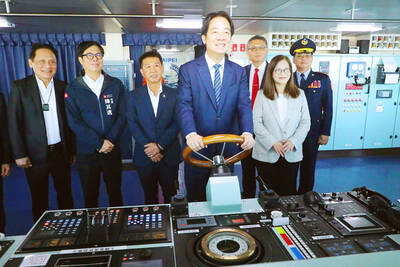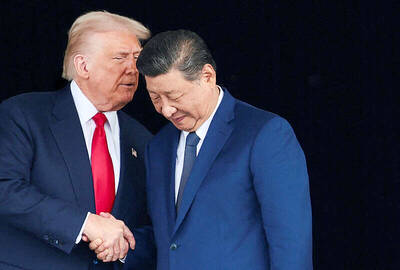An Australian low-cost airline and a Canadian luxury resort and casino developer have launched two ambitious projects that aim to revolutionize Vietnam’s fast-growing tourism industry.
Jetstar, the budget offshoot of Australian carrier Qantas, teamed up with Vietnam’s Pacific Airlines to launch Jetstar Pacific on Friday, setting the stage for a dogfight with state-run Vietnam Airlines.
The following day Canadian developers broke ground on what they say will become Vietnam’s premier destination, a US$4.2 billion resort and casino strip near southern Ho Chi Minh City, scheduled to kick off in late 2010.
Between them, the two projects push forward a tourism industry that has grown strongly since the country emerged from post-war isolation in the 1990s to accept a trickle of backpackers.
Vietnam now aims to boost its domestic and international tourism industry — which has grown into one of the country’s five top economic sectors — to take on Southeast Asian neighbors such as Thailand and Malaysia.
Vietnam last year received 4.2 million foreign visitors, 16 percent more than in 2006. The World Travel and Tourism Council ranks it as No. 4 on its list of the world’s fastest growing travel destinations.
Visitors from China made up the largest group last year, followed by South Korea, the US, Japan and Australia.
Jetstar Pacific — at a lavish Hanoi launch gala on Friday, featuring Aussie marketing glitz, dance shows and lots of dry ice — promised to shake up Vietnam’s aviation sector.
“As Vietnam’s first low-cost, value-based airline, Jetstar Pacific will change air travel in Vietnam by making it more affordable for more people to fly,” said Jetstar Pacific chief executive officer Luong Hoai Nam.
The airline now has four Boeing 737s, with four more to come this year, and plans to add 30 Airbus A320s by 2014 with the option of drawing in additional Jetstar aircraft from the regional fleet.
Jetstar’s CEO Alan Joyce said the carrier entered Vietnam — an economy of 86 million people with a decade of growth more than 7 percent — hoping to “tap into a huge untapped market as the economy grows.”
“We felt that if you get your timing right you could be the biggest brand in Asia,” he said. “Vietnam is a very important part in that jigsaw puzzle.”
Vietnam, where many early visitors were put off by state-run hotels and the stodgy service, has now embarked on building up a string of luxury hotels in major cities and seaside areas to cash in on the high-end tourism sector.
International hotels are starting to crowd the “China Beach” area near Danang, and major resort plans are on the drawing board for the southern island of Phu Quoc, which lies off the Cambodian coast.
Toronto-based Asian Coast Development Ltd (ACDL) hopes to trump them all with the Ho Tram Strip of resorts and “Las Vegas-style” casinos in Ba Ria-Vung Tau Province, 80km southwest of Ho Chi Minh City.
“This is going to be the largest development of its kind in the history of Vietnam,” ACDL chairman Michael Aymong said.
“We’re building five major resorts, two full-scale casinos, a Greg Norman golf course, a celebrity tennis facility, a marina and a Dolphin Quest marine habitat, where families can swim face-to-face with dolphins,” he said.
The first phase will include two hotels with 2,300 rooms, retail areas and a convention center, and the entire 169-hectare stretch is scheduled to be finished within a decade.
Vietnam bans gambling for its citizens but allows foreign passport holders to visit casinos and use the betting facilities of major hotels.
Aymong said he could not comment on what Vietnam’s government may do but added: “I imagine that the government will examine and consider allowing Vietnamese to gamble in the next two or three years.”
For now, he said, “we’re targeting the Chinese, the Koreans, the Japanese, the Australians and the Russians.”
He said the casino and resort strip would be a family-friendly destination with a strong environmental theme and complement — rather than compete with — Macau.
“This is a different type of product,” he said. “It’s a destination resort. Our real competition is going to be Singapore.”

CALL FOR SUPPORT: President William Lai called on lawmakers across party lines to ensure the livelihood of Taiwanese and that national security is protected President William Lai (賴清德) yesterday called for bipartisan support for Taiwan’s investment in self-defense capabilities at the christening and launch of two coast guard vessels at CSBC Corp, Taiwan’s (台灣國際造船) shipyard in Kaohsiung. The Taipei (台北) is the fourth and final ship of the Chiayi-class offshore patrol vessels, and the Siraya (西拉雅) is the Coast Guard Administration’s (CGA) first-ever ocean patrol vessel, the government said. The Taipei is the fourth and final ship of the Chiayi-class offshore patrol vessels with a displacement of about 4,000 tonnes, Lai said. This ship class was ordered as a result of former president Tsai Ing-wen’s (蔡英文) 2018

‘SECRETS’: While saying China would not attack during his presidency, Donald Trump declined to say how Washington would respond if Beijing were to take military action US President Donald Trump said that China would not take military action against Taiwan while he is president, as the Chinese leaders “know the consequences.” Trump made the statement during an interview on CBS’ 60 Minutes program that aired on Sunday, a few days after his meeting with Chinese President Xi Jinping (習近平) in South Korea. “He [Xi] has openly said, and his people have openly said at meetings, ‘we would never do anything while President Trump is president,’ because they know the consequences,” Trump said in the interview. However, he repeatedly declined to say exactly how Washington would respond in

WARFARE: All sectors of society should recognize, unite, and collectively resist and condemn Beijing’s cross-border suppression, MAC Minister Chiu Chui-cheng said The number of Taiwanese detained because of legal affairs by Chinese authorities has tripled this year, as Beijing intensified its intimidation and division of Taiwanese by combining lawfare and cognitive warfare, the Mainland Affairs Council (MAC) said yesterday. MAC Minister Chiu Chui-cheng (邱垂正) made the statement in response to questions by Democratic Progressive Party (DPP) Legislator Puma Shen (沈柏洋) about the government’s response to counter Chinese public opinion warfare, lawfare and psychological warfare. Shen said he is also being investigated by China for promoting “Taiwanese independence.” He was referring to a report published on Tuesday last week by China’s state-run Xinhua news agency,

‘ADDITIONAL CONDITION’: Taiwan will work with like-minded countries to protect its right to participate in next year’s meeting, the foreign ministry said The US will “continue to press China for security arrangements and protocols that safeguard all participants when attending APEC meetings in China,” a US Department of State spokesperson said yesterday, after Beijing suggested that members must adhere to its “one China principle” to participate. “The United States insists on the full and equal participation of all APEC member economies — including Taiwan — consistent with APEC’s guidelines, rules and established practice, as affirmed by China in its offer to host in 2026,” the unnamed spokesperson said in response to media queries about China putting a “one China” principle condition on Taiwan’s